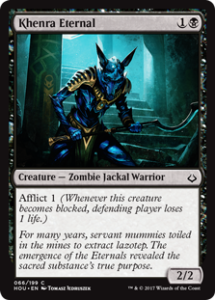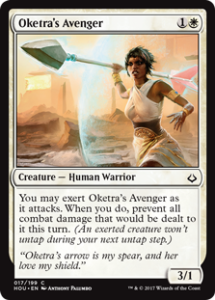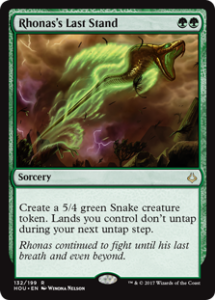Hour of Devastation prerelease has come and gone, and aggro is still good. Exert remains a powerful mechanic that punishing blocking and encourages aggression. I saw plenty of slower decks at prerelease, but all the best ones I witnessed (in my admittedly small sample size) were curving out and disrupting their opponents’ plans. However, playing against (and with) them felt appreciably different than it did when it was just Amonkhet.

An obvious affliction
Afflict plays very differently than Exert. Exert makes blocking profitably hard to do, whereas Afflict makes blocking painful to do. I expected Afflict to really change the feel of the format, and I was wrong. Afflict just wasn’t all that important. Let’s consider two simple two drops with these mechanics: Nef-Crop Entangler and Khenra Eternal.
Nef-Crop Entangler gets in two damage when the coast is clear and attacks for three damage when it’s not. It either eats a removal spell or trades up (either for a larger, more expensive creature or for multiple blockers).* Nef-Crop Entangler is flexible, produces value, and usually demands an answer because it’s hard to outclass it with a two- to four-mana blocker. Khenra Eternal either trades for an equivalent creature or gets stonewalled, end of story. Sure, Khenra Eternal is a less pushed card, but Afflict is also a less pushed mechanic than Exert.
*Or it’s on blocking duty, but Nef-Crop Entangler was never meant to block.
The core of this difference is choice: Exert gives you a choice which lets you maximize the value of your attack. Afflict gives your opponent a choice which lets them maximize the value of their block. This doesn’t mean that designwise Afflict is a worse mechanic, but it does mean it’s fundamentally weaker (just as Browbeat-style punisher mechanics are weaker than the sum of their parts and Crosis’s Charm is stronger than the sum of its parts). A consequence of this is that Afflict has less effect on the format alongside the still-powerful Exert.

A subtle but appreciable shift
I had the good fortune of opening a sealed pool with four copies of Oketra’s Avenger (and two copies of Rhonas’s Stalwart). It’s not quite Gust Walker (the best or second-best common in Amonkhet, depending on how you rate Magma Spray), but it does attack even better when you don’t have to exert. I found its play pattern and Rhonas’s Stalwart‘s to feel really different from what we’d seen before.
In Amonkhet, Gust Walker, Nef-Crop Entangler, and Emberhorn Minotaur (some of the premier common exert creatures) got larger and evasive. They made blocking hard to do because they restricted how you were able to block. To a lesser extent, Hooded Brawler accomplished this by becoming enormous. They felt like creatures pushing themselves to the limit. They were hard to block because they came from a world where (mechanically and lorewise) blocking simply wasn’t done. When blocking had to be done, it usually requiring holding back from attacking in order to multi-block.
In Hour of Devastation, only Khenra Scrapper continues this play pattern. The Exert creatures that care about attacking now have spell effects (like those seen on Amonkhet’s uncommon Exert creatures). Oketra’s Avenger doesn’t restrict your blocks or have any ability to force in damage—she just rumbles in demanding tribute. There’s something crueler there than flying over for damage or demanding an awkward block (like an even meaner Bitterblade Warrior or Rhet-Crop Spearmaster). Rhonas’s Stalwart looks like previous Amonkhet creatures (it gets bigger and has a limited form of evasion), but its form of evasion demands the sacrifice of one powerful creature (whereas in Amonkhet you could and often did answer Exert by blocking with multiple creatures).
I recognize that the differences between Gust Walker, Nef-Crop Entangler, Rhonas’s Stalwart, and Oketra’s Avenger are small and subtle (and possibly more in my mind than in the cards), but they felt appreciably different from how creature combat was before. Combat is meaner, demanding more specific answers rather than than creatures banding together. It’s simple design tweaks like these that can really change the flavor of how a mechanic plays.

Overall, I had a blast at prerelease weekend. Rhonas’s Last Stand proved to be awful in my aforementioned GW deck. You’d expect a GG 5/4 to be outstanding when you’re beating face, but it turned out that spending four to six mana for 5/4 and contorting my curve wasn’t ever worth it. Even when it didn’t die immediately, it prevented me from playing two other creatures. My second deck was a spicy four color control deck with plenty of removal and The Scarab God. Control definitely isn’t dead, but it lost to a deck with Earthshaker Khenra, Insult // Injury, and Glorybringer (and some other rares, but really it lost to Oketra’s Monument).
All in all, I expect Hour of Devastation Limited to be a fun twist on Amonkhet. Exert remains excellent, but there are way fewer common creatures that Exert on offense. Fixing is also extremely plentiful, removal is better, Afflict is a weak replacement for the lost Exert creatures, and the insanely fast Cartouche/Trial starts are going to be much rarer. Aggro looks to still be powerful, but the format might slow down enough that folks are no longer desperate for one drops in order to start racing on turn two.
Here’s looking forward to another brand new format to explore, as well as playing the last small set ever.
And, as always, thanks for reading.
—Zachary Barash
Zachary Barash is a New York City-based game designer. He works for Kingdom Death: Monster, has an MFA in Game Design from NYU, and does freelance game design.
His favorite card of the month is Mark of Mutiny. It’s not the most beginner-friendly design, but it teaches players that Threatens are for ending the game, not doing a medium amount of damage. If you play the card as a finisher, its downside is actually upside, and that inversion is really cool.

